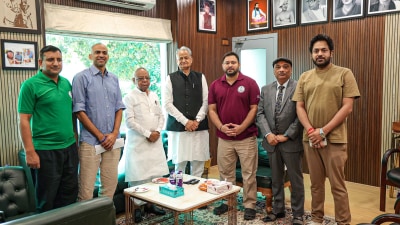Stay updated with the latest - Click here to follow us on Instagram
The Fine Print
Even after 18 years of doing this job every day of my life,I cannot believe that all the magic that is unleashed onto the big screen comes out of this small print reel, says Siddhesh Pawar
Film rolls have been the representation of cinema since its inception,but their digital counterparts are likely to soon render them obsolete
Even after 18 years of doing this job every day of my life,I cannot believe that all the magic that is unleashed onto the big screen comes out of this small print reel, says Siddhesh Pawar,shaking his head as he picks off the floor a big roll of film print to load it in the projector. These film prints have been symbolic of cinema,I cannot believe they will soon be gone,made obsolete.
Pawar,a loader in Eros projector room,is emotional over the flourishing trend of using digital film prints over the age-old tradition of physical prints where a film is transported to a cinema hall either on a hard disk or is directly relayed through satellite.
While at the outset,it may seem like a simple instance of technology leap,there is an ongoing debate where the old-school exhibitors support the use of physical prints whereas multiplexes and producers are increasingly in favour of the digital variety. The debate is fuelled by the fact that the digital technology comes with its own disadvantages,which take root in its history in India.
Unlike in the West,where the introduction was swift and unanimous,digital prints were launched in India in 2004 to cover the smaller towns during the opening weeks of a release. Films used to open a week later in the interiors because low ticket prices rendered sending fresh prints unremunerative since each new print costs close to Rs 1 lakh. Also,prints usually get damaged by the time they reach such screens and projection facilities are basic. In comparison,lower quality digital prints start from Rs 20,000 to Rs 80,000 per print for the best quality available in India. But digital prints are a compressed version of the data and suffer in terms of quality.
This is why Manoj Desai,the owner of G7 multiplex in Bandra and Maratha Mandir in Mumbai Central,calls digital prints a cheap replacement of their film counterparts. Producers can save anything from Rs 20,000 to Rs 60,000 per screen because of the price difference. But that compromises the projection quality,which is not fair to the viewers, he points out.
Senthil Kumar,the co-founder of Real Image,one of the key post-production companies that convert films into digital prints,offers his set of arguments to support the new technology. Most cinema halls in India dont store the physical prints properly. They can be found lying around as opposed to stored in a place that is cool,dry and away from exposure. Add to that the natural wear and tear by the end of a weeks use and your physical prints quality is already degraded. There are no such issues with digital prints and in fact,help limit piracy because they carry a code or an invisible watermark which shows up on a pirated copy,revealing its origin.
Filmmakers Ken Ghosh and Kunal Kohli,however,feel physical prints still lend an element of romance to cinema. But the battle is a losing one. The argument is never-ending,similar to whether the film roll cameras should be revived or not, says Kohli.
Numbers also back Kumar as most multiplexes across India have installed digital projectors and even some of the bigger single screens have opted for the technology. Currently,Real Image and UFO are the two big players in the market. Chennais Prasad Labs and Reliance Media Works are also said to be entering the market,given that the trend is picking up.
Also,over a period of time,Indie cinema and small budget multiplex movies have come to heavily depend on digital prints for the economy they offer. Senthil says its only a matter of time before physical prints are phased out since the digital quality will improve to match international standards.
But Desai and his contemporaries remain defiant. We run theatres where tickets are priced for the common man; they dont enjoy cushioned sofa seats or other perks of a multiplex. The least I can do for the people who come for the sole purpose of enjoying themselves is to offer them quality viewing. Besides,smaller exhibitors like me are the ones to lose if we purchase the expensive new projectors but the technology fails to take off.
Tushar Dhingra of BIG Cinemas empathises with Senthil but says it will be another five to 10 years before the change takes place throughout the country. Until then,even big multiplexes like ours continue to have at least one traditional projector to screen regional and smaller films.







